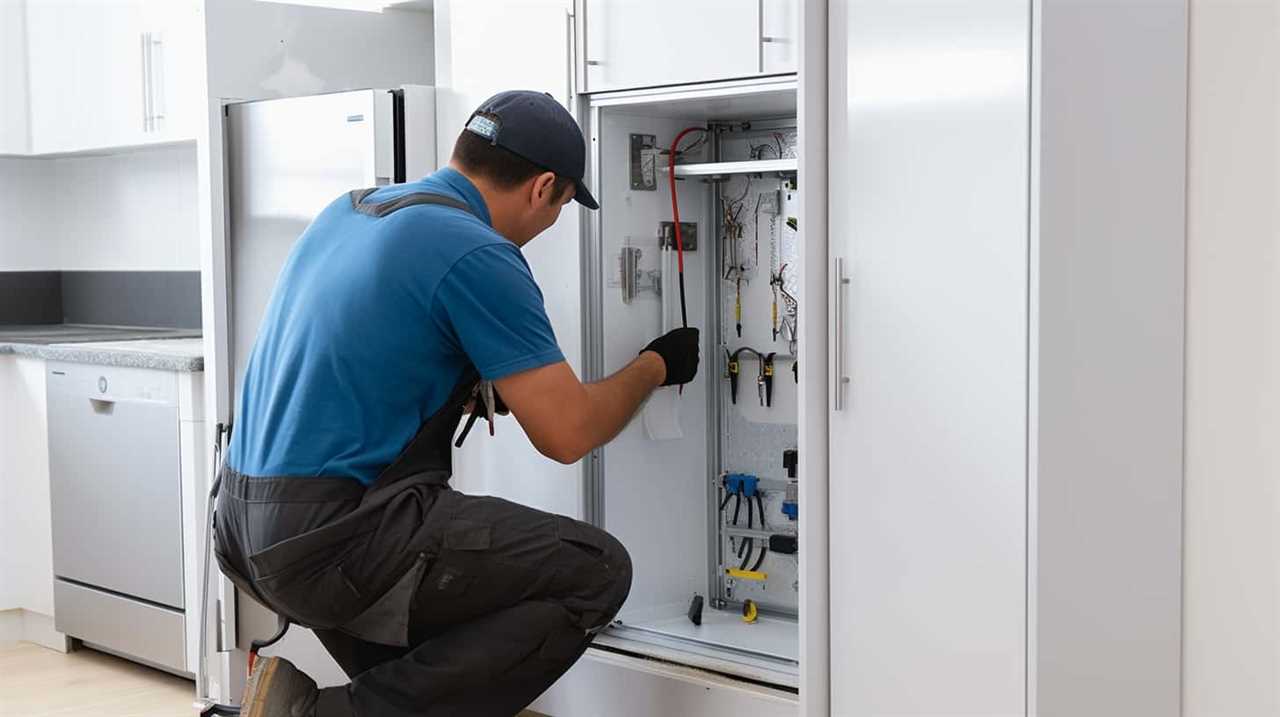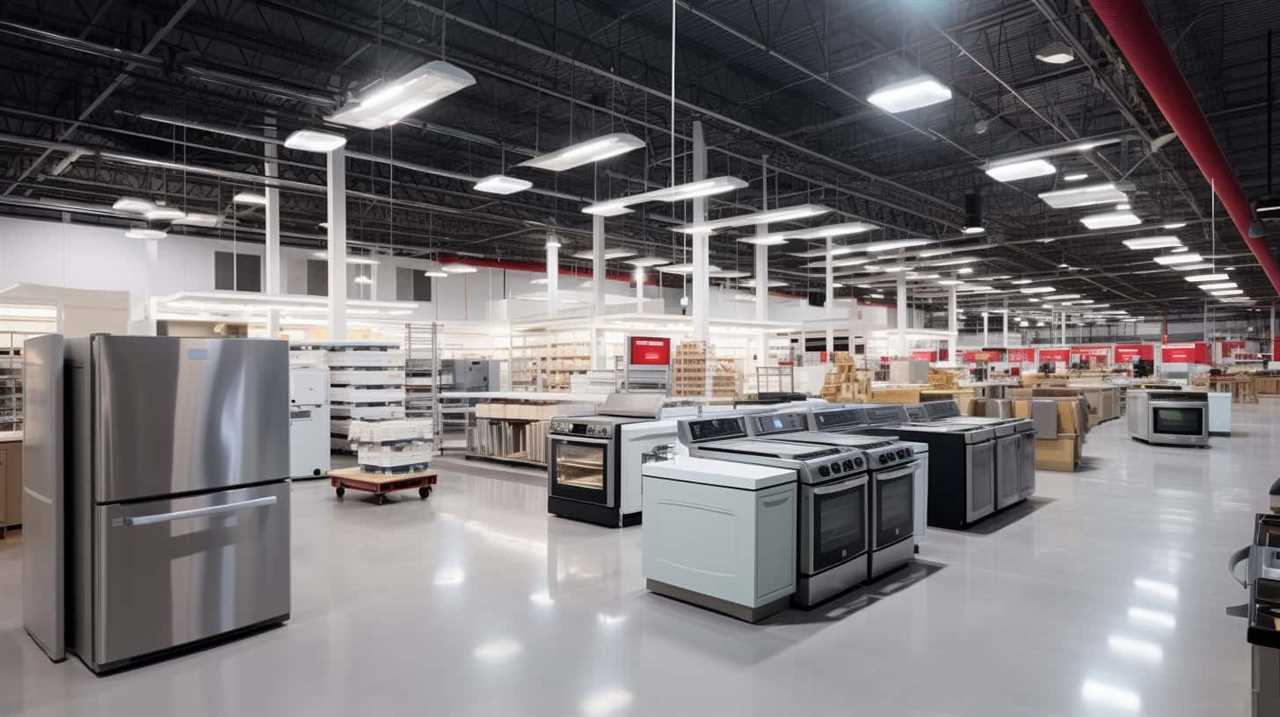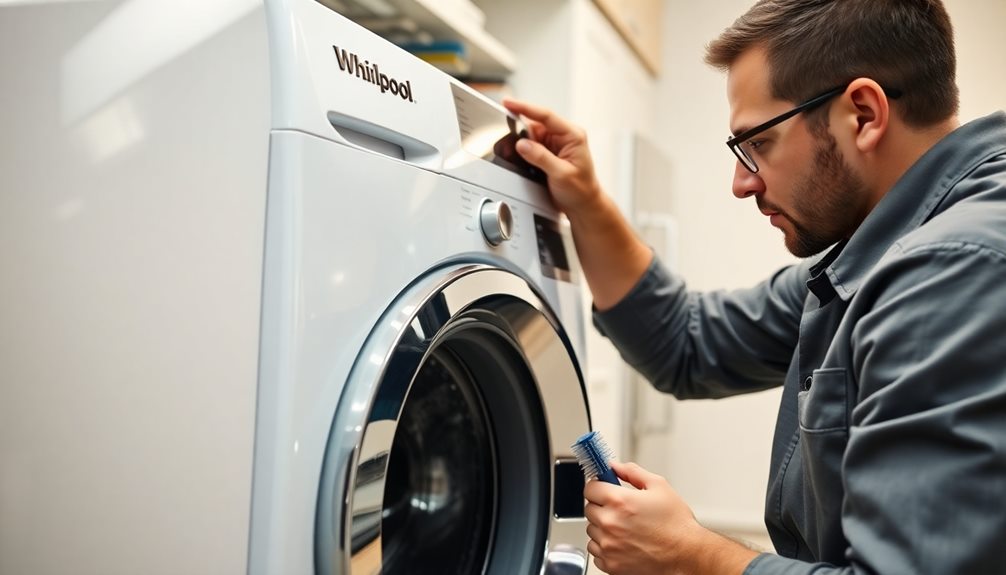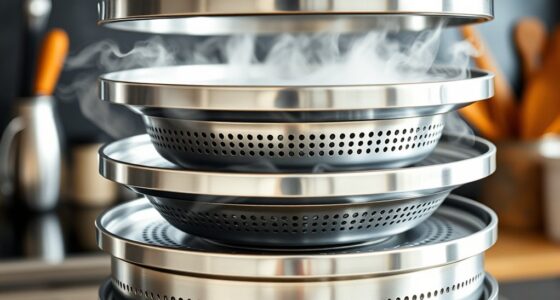Welcome to our guide on how to keep your stainless steel appliances sparkling clean! We know that it can be tough to maintain the shiny look of your stainless steel appliances. But don’t worry, we’re here to provide you with the tips and tricks you need to tackle this task.
In this comprehensive guide, we will share essential tips, techniques, and expert advice to help you achieve mastery in stainless steel appliance cleaning. From removing stubborn stains and grease to tackling smudges and fingerprints, we’ve got you covered.
So, put on your cleaning gloves and let’s dive into the world of stainless steel appliance maintenance. Get ready to transform your appliances into gleaming works of art!
Key Takeaways
- Regular cleaning is important for stainless steel appliances to prevent smudges, fingerprints, and stains.
- Natural cleaning solutions like vinegar or lemon juice mixed with water are effective and environmentally friendly.
- Essential tools and supplies for cleaning stainless steel appliances include a microfiber cloth, stainless steel cleaner, vinegar, soft-bristle brush, and non-abrasive scrub pads.
- Preparing stainless steel surfaces before cleaning and using the correct cleaning methods for different appliances is crucial for effective and safe cleaning.
Why Stainless Steel Appliances Need Regular Cleaning
We need to regularly clean our stainless steel appliances to maintain their pristine appearance and prevent buildup. Stainless steel is a popular choice for kitchen appliances due to its sleek and modern look. However, it’s susceptible to smudges, fingerprints, and stains, which can detract from its aesthetic appeal. Regular cleaning is essential to keep stainless steel appliances looking their best.

One of the main reasons why stainless steel appliances require regular cleaning is to prevent buildup. Over time, grease, food particles, and other substances can accumulate on the surface, creating a sticky residue that’s difficult to remove. By regularly cleaning with the right techniques and products, we can prevent this buildup and ensure that our appliances remain in top condition.
Using natural cleaning solutions has several benefits when it comes to maintaining stainless steel appliances. These solutions are gentle yet effective, providing a safe and non-toxic way to clean and protect the surface. Natural solutions, such as vinegar or lemon juice mixed with water, can help remove stains and restore the shine of stainless steel. Additionally, they’re more environmentally friendly and can save us money compared to harsh chemical cleaners.
Essential Tools and Supplies for Cleaning Stainless Steel Appliances
To effectively clean stainless steel appliances, gather the essential tools and supplies needed for the task. Having the right cleaning tools and supplies will ensure that you achieve the best results and maintain the pristine appearance of your stainless steel appliances. Here are some essential items you’ll need:
- Microfiber cloth: This is a must-have for cleaning stainless steel. Microfiber cloths are gentle and won’t scratch the surface. They’re also highly absorbent, making them perfect for wiping away smudges and fingerprints.
- Stainless steel cleaner: Invest in a high-quality stainless steel cleaner that’s specifically formulated for use on stainless steel appliances. Avoid using abrasive cleaners or products that contain bleach, as they can damage the surface.
- Vinegar: Vinegar is a natural cleaner that can effectively remove tough stains and grime from stainless steel. Dilute vinegar with water in a spray bottle and use it to wipe down your appliances.
- Soft-bristle brush: For cleaning hard-to-reach areas or removing stubborn stains, a soft-bristle brush can be useful. Make sure to choose a brush with bristles that won’t scratch or damage the stainless steel surface.
Preparing Stainless Steel Surfaces for Cleaning
After gathering the essential tools and supplies, it’s important to properly prepare stainless steel surfaces for cleaning. Taking the necessary pre-cleaning steps ensures that the cleaning process is effective and doesn’t cause any damage to the stainless steel. Here are three important steps to follow:

- Remove any loose debris: Before starting the cleaning process, it’s important to remove any loose debris or dirt from the stainless steel surface. This can be done by using a soft cloth or a vacuum cleaner with a brush attachment. Make sure to get into all the nooks and crannies to remove any hidden dirt.
- Use non-abrasive cleaners: Stainless steel is prone to scratches, so it’s crucial to use non-abrasive cleaners. Avoid using harsh chemicals or abrasive sponges that can damage the surface. Instead, opt for mild soapy water or specialized stainless steel cleaners that are specifically designed for this purpose.
- Test in a small area: Before applying any cleaner to the entire surface, it’s advisable to test it in a small, inconspicuous area first. This will help ensure that the cleaner doesn’t cause any discoloration or damage to the stainless steel.
By following these pre-cleaning steps and using non-abrasive cleaners, you can effectively prepare your stainless steel surfaces for cleaning without causing any harm.
Now, let’s move on to the next section, where we’ll discuss how to remove smudges and fingerprints from stainless steel appliances.
Removing Smudges and Fingerprints From Stainless Steel Appliances
To effectively remove smudges and fingerprints from stainless steel appliances, we recommend using a gentle cleaning solution and a microfiber cloth. Stainless steel appliances are prone to smudges and fingerprints, which can make them look dull and dirty. However, with the right cleaning methods, you can easily restore their shine and keep them looking brand new.
When it comes to removing oil stains and fingerprints from stainless steel appliances, it’s important to avoid harsh chemicals that can damage the surface. Instead, opt for natural cleaning solutions that are safe and effective. One option is to mix equal parts of distilled white vinegar and water in a spray bottle. Spray the solution onto the cloth and gently wipe the surface of the appliance in the direction of the grain. This will help to remove any smudges or fingerprints without leaving streaks.

Another natural cleaning solution you can use is a mixture of baking soda and water. Create a paste by mixing the two ingredients together, then apply it to the cloth and rub it onto the stainless steel surface. The baking soda acts as a gentle abrasive, helping to remove any stubborn stains or fingerprints.
Remember to always use a microfiber cloth when cleaning stainless steel appliances. Microfiber is soft and non-abrasive, making it ideal for cleaning delicate surfaces without scratching or damaging them. It also has the ability to attract and trap dirt, dust, and oils, leaving your appliances sparkling clean.
How to Safely Clean Stainless Steel Oven Racks
For safely cleaning stainless steel oven racks, we recommend using a mixture of baking soda and water. This natural cleaning solution is effective in removing burnt residue and grime without causing any damage to the stainless steel surface.
Here’s how you can safely clean your stainless steel oven racks:

- Remove the oven racks from the oven and place them in a large sink or bathtub.
- Create a paste by mixing baking soda and water in a bowl. The consistency should be thick enough to spread easily.
- Using a sponge or a soft brush, apply the baking soda paste all over the oven racks, making sure to cover both sides thoroughly. Focus on areas with burnt residue and tough stains.
- Let the paste sit on the racks for about 30 minutes to an hour. This will allow the baking soda to break down the burnt residue and loosen the grime.
- After the soaking time, scrub the racks gently with the sponge or brush to remove the loosened residue. Rinse them thoroughly with water to remove any remaining paste.
- Finally, dry the oven racks completely before placing them back in the oven.
Effective Methods for Cleaning Stainless Steel Refrigerator Shelves
When it comes to cleaning stainless steel refrigerator shelves, it’s important to use gentle cleaning solutions and avoid abrasive materials. Stainless steel can be easily scratched, so it’s best to opt for non-abrasive cleaners and soft cloths or sponges.
This will help to maintain the shine and integrity of your stainless steel shelves without causing any damage.
Gentle Cleaning Solutions
We frequently use a gentle cleaning solution to effectively clean the stainless steel refrigerator shelves. Here are three eco-friendly cleaning techniques that you can use:
- Vinegar Solution: Mix equal parts of white vinegar and water in a spray bottle. Spray the solution onto the shelves and let it sit for a few minutes. Then, wipe it off with a soft cloth. Vinegar is a natural disinfectant and can remove stains and fingerprints from stainless steel surfaces.
- Baking Soda Paste: Make a paste by mixing baking soda with water. Apply the paste to the shelves and gently scrub with a soft cloth or sponge. Baking soda is a mild abrasive that can remove tough stains without scratching the surface.
- Lemon Juice: Cut a lemon in half and rub it directly onto the shelves. The acidic properties of lemon juice can help remove stains and give your stainless steel shelves a fresh scent.
Using these gentle cleaning solutions will ensure that your stainless steel refrigerator shelves remain clean and shiny without causing any damage to the surface.

Avoid Abrasive Materials
To ensure the longevity and shine of your stainless steel refrigerator shelves, it’s important to avoid using abrasive materials during the cleaning process. Abrasive materials can cause scratches and damage the surface of your shelves, compromising their appearance and durability. Instead, opt for gentle cleaning techniques that effectively remove dirt and grime without harming the stainless steel.
One of the best cleaning techniques is to use a mild soap or detergent mixed with warm water. Apply the solution to a soft cloth or sponge and gently wipe the shelves in a circular motion. Rinse with clean water and dry thoroughly to prevent water spots.
Another effective method is to use vinegar or lemon juice diluted with water. These natural acidic solutions help remove stains and restore the shine of your stainless steel refrigerator shelves. Remember to always avoid using abrasive scrub brushes, scouring pads, or harsh chemicals, as they can cause irreversible damage.
Quick and Easy Ways to Clean Stainless Steel Stovetops
To start quickly and easily cleaning stainless steel stovetops, begin by wiping down the surface with a microfiber cloth and a solution of warm water and mild dish soap. This will help remove any grease or grime that may have accumulated. After wiping down the surface, make sure to dry it thoroughly to prevent water spots.

Here are three quick tips for cleaning stainless steel stovetops:
- Use vinegar: For stubborn stains or burnt-on food, mix equal parts vinegar and water in a spray bottle. Spray the solution onto the stovetop and let it sit for a few minutes. Then, use a soft cloth or sponge to scrub away the stain. Rinse the surface with water and dry it thoroughly.
- Baking soda paste: Make a paste by mixing baking soda with a small amount of water. Apply the paste to any tough stains or greasy spots on the stovetop. Let it sit for a few minutes, then gently scrub the area with a soft cloth or sponge. Rinse with water and dry thoroughly.
- Olive oil: To give your stainless steel stovetop a shiny finish, apply a small amount of olive oil to a soft cloth. Rub the oil onto the surface in a circular motion. This will help remove any fingerprints or smudges and leave your stovetop looking polished.
Deep Cleaning Stainless Steel Dishwasher Interiors
To properly maintain the cleanliness of stainless steel appliances, such as stovetops, we should also address the deep cleaning of the stainless steel dishwasher interiors. Deep cleaning the dishwasher interiors is essential to ensure optimal performance and prevent rust formation in stainless steel dishwashers.
Here are some steps to effectively deep clean the stainless steel dishwasher interiors:
- Remove any debris: Before starting the deep cleaning process, remove any visible debris or food particles from the dishwasher. This can be done by wiping the interior with a damp cloth or sponge.
- Use a stainless steel cleaner: Apply a stainless steel cleaner specifically designed for use on appliances. Spray the cleaner onto a soft cloth or sponge, and then gently wipe the interior of the dishwasher. Ensure that you cover all surfaces, including the walls, racks, and door.
- Rinse and dry: After cleaning, rinse the interior of the dishwasher with warm water to remove any residue from the cleaner. Then, dry the surfaces thoroughly with a clean cloth to prevent water spots or streaks.
Polishing Stainless Steel Surfaces to Restore Their Shine
Let’s restore the shine of stainless steel surfaces by polishing them with a stainless steel polish. Polishing stainless steel surfaces not only enhances their appearance but also helps to protect them from stains and scratches. Here are three effective polishing techniques that you can try at home:

- Use a microfiber cloth: Start by wiping the surface with a damp microfiber cloth to remove any dirt or grime. Then, apply a small amount of stainless steel polish onto a clean microfiber cloth and gently rub it onto the surface in a circular motion. Continue polishing until you achieve the desired shine.
- Baking soda paste: Create a paste by mixing baking soda with water until it forms a thick consistency. Apply the paste onto the stainless steel surface and rub it in using a soft cloth. Rinse with warm water and dry thoroughly. This DIY cleaning hack is especially useful for removing stubborn stains and restoring shine.
- Vinegar solution: Mix equal parts of vinegar and water in a spray bottle. Spray the solution onto the stainless steel surface and wipe it clean with a microfiber cloth. Vinegar helps to dissolve grease and grime, leaving your stainless steel appliances sparkling and shiny.
Preventing Water Spots and Stains on Stainless Steel Appliances
To prevent water spots and stains on stainless steel appliances, we can take a few simple steps to maintain their cleanliness and shine.
One effective way is to wipe down the appliances regularly with a soft cloth and warm soapy water. This will remove any dirt or grime that may be present on the surface. After cleaning, make sure to thoroughly dry the appliance using a clean, lint-free cloth to prevent water spots from forming.
Another important step to prevent water spots is to avoid using abrasive cleaners or scrubbing pads on stainless steel surfaces. These can scratch the surface and make it more prone to water spots and stains. Instead, opt for gentle cleaning solutions specifically designed for stainless steel. These solutions are usually non-abrasive and can effectively remove fingerprints and smudges without damaging the surface.
Additionally, it’s helpful to regularly apply a stainless steel cleaner or polish to the appliances. This will create a protective barrier that can repel water and prevent stains from forming. When applying the cleaner or polish, make sure to follow the manufacturer’s instructions for best results.

Removing Stubborn Stains and Grease From Stainless Steel
When it comes to removing stubborn stains and grease from stainless steel appliances, we’ve found several effective cleaning methods that yield great results.
Additionally, it’s important to take steps to prevent future stains and keep your appliances looking their best.
We recommend using specific cleaning products that are safe for stainless steel and provide the best results.
Effective Cleaning Methods
To effectively remove stubborn stains and grease from stainless steel, we rely on the power of a compound preposition like ‘with’.

Here are three effective cleaning methods that can help you achieve a sparkling clean stainless steel appliance:
- Baking Soda Paste:
Create a paste by mixing baking soda with water until it has a toothpaste-like consistency. Apply the paste to the stains or grease, and gently scrub with a non-abrasive cloth. Rinse with water and dry thoroughly. - Vinegar Solution:
Mix equal parts of white vinegar and water in a spray bottle. Spray the solution onto the stained areas and let it sit for a few minutes. Wipe clean with a microfiber cloth, following the grain of the stainless steel. - Lemon Juice:
Cut a lemon in half and rub the cut side directly onto the stains or grease. Allow the lemon juice to sit for a few minutes before wiping it off with a damp cloth.
These cleaning techniques aren’t only effective in removing stubborn stains and grease, but they’re also eco-friendly options.
Preventing Future Stains
To prevent future stains and effectively remove stubborn stains and grease from stainless steel appliances, we rely on a combination of regular cleaning and protective measures. One of the main concerns with stainless steel is the potential for rust. To prevent rust from forming, it’s important to keep the surface clean and dry.
Wipe down your appliances regularly with a soft cloth to remove any moisture or residue. Additionally, applying a stainless steel cleaner or polish can help maintain the shine and protect against future stains. These products create a barrier that repels water and prevents grease from sticking to the surface.

By taking these preventive measures, you can ensure that your stainless steel appliances stay clean and free from stubborn stains.
Now, let’s move on to the next section where we’ll discuss recommended cleaning products.
Recommended Cleaning Products
We rely on using specialized cleaners to effectively remove stubborn stains and grease from stainless steel appliances. When it comes to cleaning stainless steel, it’s important to choose the right products that are both effective and safe for the environment.
Here are three recommended cleaning methods for tackling tough stains and grease on your stainless steel appliances:

- Vinegar and water solution: Mix equal parts vinegar and water in a spray bottle. Spray the solution onto the surface of the appliance and wipe it clean with a microfiber cloth. Vinegar is a natural, eco-friendly option that can help remove grease and stains without damaging the stainless steel.
- Baking soda paste: Create a paste by mixing baking soda with water. Apply the paste to the stained area and gently scrub with a soft cloth or sponge. Baking soda is a gentle yet powerful cleaner that can effectively remove stubborn stains and grease.
- Commercial stainless steel cleaner: Look for commercial cleaners specifically designed for stainless steel appliances. These cleaners are formulated to remove tough stains and grease while leaving a protective layer on the surface. Be sure to follow the instructions on the product for best results.
Cleaning Stainless Steel Appliance Handles and Knobs
For a thorough cleaning of stainless steel appliance handles and knobs, follow these three simple steps.
First, gather the necessary supplies: a microfiber cloth, warm water, and a mild detergent. Avoid using abrasive cleaners or scrub brushes, as they can damage the stainless steel surface.
Once you have your supplies ready, dampen the microfiber cloth with warm water and add a small amount of mild detergent. Gently scrub the handles and knobs in a circular motion, paying extra attention to any areas with built-up grime or fingerprints. Rinse the cloth with clean water and wipe away any soap residue.
Next, dry the handles and knobs thoroughly with a clean, dry microfiber cloth to prevent water spots.

Finally, for an added layer of protection, consider applying a stainless steel cleaner or polish specifically designed to protect stainless steel appliance handles. This will help to repel fingerprints and keep your handles looking shiny and new.
Proper Maintenance Tips to Keep Stainless Steel Appliances Looking New
To maintain the pristine look of stainless steel appliances, it’s important that we incorporate proper maintenance practices into our cleaning routine. Here are some cleaning hacks and a maintenance schedule to help keep your stainless steel appliances looking new:
- Regular Cleaning:
- Wipe down your appliances with a soft, microfiber cloth and warm soapy water.
- Avoid using abrasive cleaners or scrub brushes that can scratch the surface.
- Dry the appliances thoroughly to prevent water spots.
- Removing Fingerprints:
- Stainless steel appliances are notorious for showing fingerprints.
- To remove them, try using a mixture of vinegar and water or a stainless steel cleaner.
- Apply the solution to a cloth and gently rub the fingerprints away, following the grain of the stainless steel.
- Polishing:
- Over time, stainless steel appliances may lose their shine.
- To restore it, use a stainless steel polish.
- Apply a small amount to a cloth and buff the surface in circular motions.
- This will help remove any stubborn stains or smudges and leave your appliances looking brand new.
Frequently Asked Questions About Cleaning Stainless Steel Appliances
Let’s address some common questions about cleaning stainless steel appliances. Proper stainless steel appliance maintenance is essential to keep them looking new. Here are some frequently asked questions and their answers to help you maintain the sparkling clean appearance of your stainless steel appliances.
Q: What’s the best way to clean stainless steel appliances?
A: The best cleaning technique for stainless steel appliances is to use a soft cloth or sponge with warm water and mild dish soap. Avoid abrasive cleaners or scrub brushes as they can scratch the surface. After cleaning, rinse with water and dry with a soft cloth to prevent water spots.

Q: How do I remove fingerprints from stainless steel appliances?
A: Fingerprints can be easily removed by spraying a small amount of glass cleaner or stainless steel cleaner onto a cloth and gently wiping the surface in the direction of the grain. Avoid spraying directly onto the appliance to prevent streaks.
Q: Can I use vinegar to clean stainless steel appliances?
A: While vinegar is a natural cleaner, it’s acidic and can damage the protective layer on stainless steel appliances. It’s best to avoid using vinegar for cleaning.
Q: How often should I clean my stainless steel appliances?
A: It’s recommended to clean stainless steel appliances regularly, at least once a week, to prevent buildup and maintain their shine. However, if you notice any spills or stains, it’s best to clean them immediately to prevent them from becoming more difficult to remove.
Frequently Asked Questions
Can I Use Abrasive Cleaners on Stainless Steel Appliances?
Using abrasive cleaners on stainless steel appliances can damage the surface and cause scratches. It’s important to be gentle when cleaning stainless steel. Instead, opt for non-abrasive sponges and soft cloths to avoid any potential damage.

To maintain the shine of your stainless steel appliances, regularly clean them with mild soap and water, and dry them thoroughly to prevent water spots. Additionally, using stainless steel cleaner specifically designed for this purpose can help keep your appliances looking sparkling clean.
How Often Should I Clean Stainless Steel Appliances?
Cleaning stainless steel appliances is essential to maintain their pristine appearance. To keep them looking their best, we recommend cleaning them regularly.
Removing fingerprints from stainless steel appliances can be easily done using a gentle cleaner and a microfiber cloth. For daily use, the best stainless steel cleaner is one that’s specifically designed for this purpose.
Can I Use Vinegar to Clean Stainless Steel Surfaces?
Yes, you can definitely use vinegar to clean stainless steel surfaces. It’s a great natural alternative to harsh chemical cleaners. Vinegar helps to remove grease, fingerprints, and smudges from your appliances.

However, if you don’t like the smell of vinegar, you can also try using lemon juice. It has similar cleaning properties and leaves a fresh citrus scent behind.
Both options are effective in keeping your stainless steel appliances sparkling clean.
What Is the Best Way to Remove Rust Stains From Stainless Steel Appliances?
When it comes to removing rust stains from stainless steel appliances, we’ve tried it all. From the best homemade rust removers to professional techniques, we’ve seen it all.
Rust stains can be a real eyesore, but fear not! We’ve found the solution that works like magic. It’s a simple combination of baking soda and lemon juice. Just mix them together to create a paste, apply it to the rust stain, let it sit for a few minutes, and then scrub it off.

Voila! Your stainless steel appliances will be gleaming again.
How Do I Prevent Scratches on Stainless Steel Surfaces?
To prevent scratches on stainless steel surfaces, we follow a few key steps.
First, we make sure to use soft, non-abrasive cleaning tools like microfiber cloths or gentle scrub brushes.
We also avoid using harsh chemicals or abrasive cleaners that can damage the surface.

Additionally, we recommend using a protective film or cover on high-traffic areas to minimize the risk of scratches.
Conclusion
In conclusion, keeping your stainless steel appliances sparkling clean isn’t only important for their appearance but also for their longevity.
By regularly cleaning and maintaining them, you can ensure that they continue to shine like new.
Just like how the gleaming surface of stainless steel reflects light, a well-maintained appliance reflects the care and attention you put into your home.

So, grab your cleaning supplies and let your appliances shine bright like a diamond!










